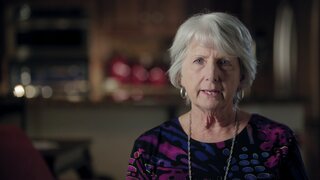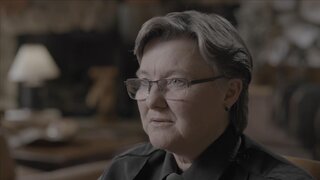Create a free profile to get unlimited access to exclusive videos, breaking news, sweepstakes, and more!
Man Kidnaps Woman From Side Of The Road And Stores Her Body In Freezer For Years
Denise Huber vanished after driving home at night from a concert in California — and it would take years for police to find her body stored at the home of a disturbing killer.
The Hubers lived an idyllic life in Newport Beach, California, but in 1991, it all took a dark, tragic turn.
Dennis and Ione Huber, along with their daughter, Denise, were enjoying another summer in the upscale Southern California neighborhood where they lived. Denise had graduated with a degree in social sciences from the University of California Irvine, and, at the age of 23, continued to live at home with her parents while working at a local restaurant.
“She was enjoying life and getting ready to really settle down and get a more permanent-type job,” Denise’s mother, Ione Huber, told Oxygen’s “Buried in the Backyard,” airing Thursdays at 8/7c on Oxygen.
However, the trajectory of Denise’s life was cruelly halted in June 1991. The Huber family woke up on June 3 only to realize Denise’s bed was empty. She’d gone to a concert with a work friend, Rob, the night before, and her parents assumed she’d just spent the night with Tammy, another friend from work. But when Denise was still missing by the time her parents returned home that evening, they really began to worry.
The concerned parents called their daughter's friends in an effort to track her down, and were surprised to hear Tammy had not heard from Denise recently, much less hosted her at her house the night before. When they contacted Rob, he also said that he didn’t know where Denise was and claimed she’d dropped him off at home the night before after the show.
Determined to figure out what happened, Denise’s friend Debbie decided to get in her car and retrace the route Denise likely would have taken home after the concert the night before. During the drive, she made a shocking discovery: Denise’s car had been left on the side of a fairly isolated freeway, but Denise herself was nowhere to be found.
The police begin taking a closer look at the people in Denise’s inner circle.
Denise’s car had a flat tire, and a pair of pantyhose sat abandoned in the front seat. Still, there was nothing else in the car. Denise’s purse and her car keys were all missing, striking fear in the hearts of her loved ones.
“I don’t know what’s going on. It’s just such a helpless feeling,” Ione told producers.
Police traveled to where Denise’s car was to search for clues, dispatching helicopters overhead for any sign of Denise. The K-9 unit was also utilized in the search, and the dogs were able to trace Denise’s scent 75 yards away from her car before it disappeared. Investigators were stunned.
“It appeared that Denise had just totally vanished,” David Snowden, former chief of the Costa Mesa Police Department, told producers.
The following morning, investigators met with the Hubers for an interview, but when asked if they thought there was anyone who may want to harm Denise, they had no ideas. Denise was beloved by her social group and worked with friends as a server at The Old Spaghetti Factory.
Investigators began to trace Denise’s steps on the night she went missing. Denise had met up with Rob for the concert that night — so it only made sense to bring Rob in for questioning. Once at the station, Rob confirmed he had gone to the concert with Denise and they had gone out for drinks at a local bar afterward. At the end of the night, close to 2 a.m., Denise dropped him off at home, he claimed.
Rob ended up passing a polygraph test, so police considered other possible suspects. They questioned Denise's other friend, Steve, who Rob claimed was romantically involved with Denise, but his alibi checked out and they let him go as well. Investigators were back at square one.
The search for a beloved daughter goes cold.
As the case wore on, Denise’s disappearance made local headlines and her parents appeared on TV to plead with the public to share any information someone may have regarding their daughter’s disappearance. Authorities, meanwhile, feared the worst.
“I believe I was convinced that Denise Huber, in fact, had been abducted. Now we needed to find who, why, and when,” Snowden recalled.
During the search for Denise, police received thousands of tips, but none led to any useful leads in the investigation. Eventually, they were forced to call it: The case had gone cold. The lack of answers left Denise’s parents utterly devastated.
“We were basically incapacitated. I could not do anything, I was so grief-stricken and worried, that, at that point, I thought, I could not go any lower,” Dennis Huber told producers.
Unfortunately for the Hubers, it would take three more years for progress to be made in their daughter’s case.
A random tip leads to answers.
Strangely enough, it was the actions of two people who never knew Denise that would eventually lead to justice in her case.
Retirees Jack and Elaine Court moved to Prescott Valley, Arizona in the 1990s to settle down and began selling paint sundries at the local swap meet. In July 1994, they met a newcomer to the flea market scene, a man named John who said he was selling painting-related items. Thinking this John character may have inventory they could sell as part of their business, Jack and Elaine accepted John’s invitation to pick up some product from his house.
Once they arrived, they noticed something strange: A moving truck was parked in his backyard that had seemingly been abandoned, judging by the overgrowth near the tires. Although the couple were able to buy their supplies and leave without incident, they were suspicious — the moving truck in John’s driveway set off alarm bells because John had claimed he’d only just moved to town six months ago.
Suspecting he may have stolen the truck, the couple secretly wrote down the license plate number and shared their concerns with a deputy police officer who'd come to buy their wares. Back at the station, the officer ran the plates and discovered the truck had indeed been reported stolen six months ago.
The deputy then traveled to John’s house. No one was home, but upon further inspection, the deputy noticed a number of things that alarmed him. There were chemicals outside of the truck and an extension cord leading from the back of it, prompting him to suspect that whoever stole the moving truck may have been using it as a drug lab.
Less than one hour later, agents from the narcotics team converged at the house with a search warrant in hand and proceeded to check out the property. In the back of the truck, they found a deep freezer, which they assumed was filled with drugs — however, what they found inside was much worse.
“Inside were plastic bags, obviously with something in it. There was an odor, and I noticed frozen blood in the bottom of the freezer,” Scott Mascher, sheriff of the Yavapai County Sheriff’s Department, told producers. “[..] When we cut the plastic bag opened and peeled it back, I could see an arm, and as we began to open the bag more, it appeared to be a young adult female."
Police examine the home of a disturbed individual.
The victim was found on her knees, with her head bent down and her arms handcuffed behind her back. Cloth had been stuffed in her mouth, which was duct taped closed. It was a gruesome scene.
Investigators were dealt another surprise when, in the midst of processing the scene, the resident responsible for the truck, a man named John Joseph Famalaro, pulled into the driveway.
Despite the presence of a body in the truck, Famalaro seemed eerily calm about what was happening, baffling investigators. They brought him in to the station for questioning, where he was strangely cooperative until they began asking about the freezer, at which point he responded, “I have nothing else to say,” and requested an attorney.
Still, despite his refusal to talk, police had probable cause to support taking him into custody and they arrested him for murder and for the theft of the moving truck. Meanwhile, investigators transported the victim’s body to the medical examiner’s office, where researchers would attempt to identify the victim.
While they waited, investigators searched Famalaro’s home. What they found was far outside of the ordinary: There were various weapons strewn about, and in the basement, they found a blood-stained hammer and dried tissue. Police also found women’s clothing, purses, and social security cards, all of which, when examined together, pointed to a disturbing conclusion.
“Authorities truly began to believe that the body in the freezer probably wasn’t the only victim,” Mascher said.
Then came the most horrifying discovery in Famalaro’s house: At the back of the basement, Famalaro had dug out a hidden underground room. Fearing that more bodies may have been buried in the secret room, authorities brought in cadaver dogs but did not find any other victims.
Still, police knew that they had a repeat offender on their hands, and they began reaching out to other agencies to keep them posted on any developments. This led them to one woman, who said she’d met Famalaro in Phoenix, Arizona and that he’d taken her to the middle of the desert, where he’d tried to strangle her. She fought him off and was forced to run to safety nude through the desert. The woman never reported the crime, but she was able to immediately identify Famalaro in a photo lineup.
Other victims also started to appear, including women who reported Famalaro had handcuffed them to beds without their consent, and other instances of disturbing and violent behavior.
“Police were suddenly wondering if they were dealing with a serial killer,” Volkze said.
The family of Denise Huber finally get justice.
Authorities in Arizona got to work contacting law enforcement agencies in the hopes of finding out the identity of their Jane Doe. It was then that they connected with investigators in California and learned the woman they found in the freezer may have been missing woman Denise Huber.
Denise’s purse was one of many that had been at Famalaro’s house and all of her identifying information was inside. They also found the clothes Denise had been wearing when she was abducted, along with newspaper clippings about Denise’s disappearance that Famalaro had collected. Fingerprints confirmed it was a match.
The family was devastated.
“I have never felt worse in my life,” Dennis said. “It’s indescribable. It’s the worst thing that can happen to you.”
An autopsy revealed Denise had been sexually assaulted and she’d died from blunt force trauma to the skull after being struck more than 30 times times in the head by what was likely a hammer, possibly the one that had been found at Famalaro’s house.
It didn’t take long for authorities to piece together what had likely happened: At the time of Denise’s disappearance, Famalaro had been running a paint business with a warehouse that was in Orange County, not far from where Denise’s car had been found abandoned. When police went to search the warehouse, they found a room in the back with walls that were, a spray of Luminol revealed, covered in blood. Further testing showed the blood belonged to both Denise and Famalaro.
Police believe Famalaro had been out hunting for victims when he came across Denise trying to fix a flat tire; he then struck her with a hammer, dragged her back to his car, handcuffed her, and took her back to his warehouse, where he raped and killed her. Famalaro had likely held on to Denise’s body with the intention of burying it, along with the evidence, in the pit that he was digging at the bottom of his house.
In July 1994, Famalaro stood trial for Denise’s murder after pleading not guilty. He was convicted of murder and kidnapping and sentenced to death. He is currently awaiting his execution at the San Quentin state prison in California.
For more information on this case and others, watch “Buried in the Backyard” on Oxygen on Thursdays at 8/7c or stream online any time at Oxygen.com.






















